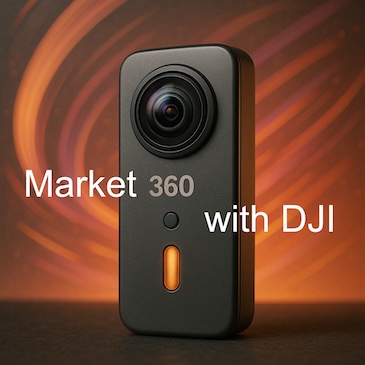Despite a promising start, 360-degree cameras have yet to achieve widespread adoption among the general public. Today, however, a new momentum may be emerging—especially with the anticipated arrival of a major player: DJI, the global giant in aerial video and stabilized cameras.

Who Currently Leads the 360-Degree Camera Market?
Insta360: The Prosumer Leader
Insta360 currently dominates the immersive camera space, especially among semi-professional and professional content creators. Its Insta360 X4 and X5 models stand out for their excellent image quality, powerful editing tools, and seamless integration with social media platforms.
Other Key Industry Players
Several other brands contribute to the diversity of the 360-degree camera market:
- Ricoh Theta: A pioneer in 360° photography, widely used in real estate.
- Kandao and Labpano: Specialized in professional VR and B2B solutions.
- GoPro Max: Positioned toward the sports and creative content segments, supported by GoPro’s well-established ecosystem.
DJI Gears Up to Enter the 360-Degree Camera Arena
DJI’s upcoming entry into the 360-degree camera market is already making waves. With strong expertise in drones, high-end sensors, and image stabilization, DJI has the potential to shake up the status quo.
Its first 360-degree camera—possibly named DJI Osmo 360—is expected to adopt a form factor similar to the GoPro Max, while offering key differentiators such as:
•Advanced software-based stabilization
•A user-friendly, intuitive experience
•Deep integration within the DJI ecosystem
The challenge is clear: without truly differentiating innovations, it will be difficult to unseat Insta360’s dominant position. But if DJI delivers something groundbreaking, it could shift the entire market.
Healthy Competition Sparks Growth
DJI’s entrance into the immersive camera space is likely to benefit the industry as a whole:
•Accelerated innovation, as seen with the rapid release of the Insta360 X5
•Increased price competition, driven by new market dynamics
•Broader audience reach, thanks to DJI’s global brand recognition and retail distribution
What’s Ahead for 360-Degree Cameras in 2025?
The 360-degree camera market may be on the verge of a new growth phase, fueled by several emerging technological trends:
- The DJI Effect: Democratization of 360° technology through more accessible design and simplified UX
- Artificial Intelligence: Automation of post-production via smart stitching, auto-corrections, and intelligent editing tools
- Spatial Computing: Devices like the Apple Vision Pro and Meta Quest 3 create renewed opportunities for immersive 360° content
- Social Media Integration: Enhanced support for short-form content on TikTok, Instagram Reels, and YouTube Shorts
Conclusion: A Niche Market with Strong Potential
The 360-degree camera market appears to be entering a strategic transition phase. If DJI’s entry is confirmed, it could serve as a catalyst, prompting the entire industry to innovate while making immersive tech more accessible to everyday users.
While still niche, 360-degree cameras hold strong potential across sectors such as professional VR, immersive media production, real estate, tourism, and perhaps soon, mainstream content creation.
